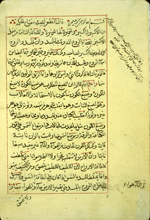Catalogue: Alchemy
-
 Mu‘ayyad al-Dīn Abū Ismā‘īl al-Ḥusayn ibn ‘Alī al-Ṭughrā’ī (d. 1121/515)
Mu‘ayyad al-Dīn Abū Ismā‘īl al-Ḥusayn ibn ‘Alī al-Ṭughrā’ī (d. 1121/515) - مؤيد الدين ابو اسماعيل الحسين ابن على الطغرائى
The poet and highly-placed administrative secretary in Isfahan, al-Ṭughrā’ī was also a well-known and prolific writer on astrology and alchemy.
His most famous alchemical book was a large treatise incorporating extracts from earlier writers, Mafatih al-rahmah wa-masabih al-ḥikmah, though he composed a considerable number of other treatises on the topic, including Kitāb Haqa'iq al-istishhad, a rebuttal of a refutation of alchemy written by Ibn Sīnā which al-Ṭughrā’ī composed in 1112/505.
NLM possesses a short, otherwise unrecorded, treatise (MS A 65, item 2) titled Miftāḥ al-ḥikmah, possible related in some way to the larger Mafatih al-rahmah wa-masabih al-ḥikmah, as well as three untitled extracts from unspecified writings by al-Ṭughrā’ī (MS A 70, items 11, 16, and 21).
For a list of his alchemical writings, see Ullmann, Natur, pp. 252-3.
-
 Miftāḥ al-ḥikmah (MS A 65, item 2)
Miftāḥ al-ḥikmah (MS A 65, item 2) - (The Key of Wisdom)
- مفتاح الحكمه
- by Mu‘ayyad al-Dīn Abū Ismā‘īl al-Ḥusayn ibn ‘Alī al-Ṭughrā’ī (d. 1121/515)
- مؤيد الدين ابو اسماعيل الحسين ابن على الطغرائى
This otherwise unrecorded, short alchemical treatise with the title Miftāḥ al-ḥikmah, may by an extract from or related to his famous alchemical compendium having a similar title: Kitaf Mafatih al-rahmah wa-masabih al-ḥikmah. On the other hand, a comparison of the NLM copy of Miftāḥ al-ḥikmah with a copy of his well-known compendium Kitab Mafatih al-rahmah wa-masabih al-ḥikmah (London, Wellcome Library for the History and Understanding of Medicine, MS Arabic 21) did not reveal any identical portions.
No other copy has been identified.
Miftāḥ al-ḥikmah ( MS A 65, item 2)
Illustrations
The beginning of an otherwise unrecorded copy of an alchemical treatise of al-Ṭughrā’ī, a famous alchemist of the early 12th century. His name is given in the first line, along with the title Miftāḥ al-ḥikmah (The Key of Wisdom). The copy was completed by Muḥammad Ṣādiq ibn Muṣṭafá al-Anṭākī al-Istanbūlī al-Ḥanafī in the month of Jumadá I 1123 (= March-April 1712).
Physical Description
Arabic. 4 leaves (fols. 148b-151a). Dimensions 20.7 x 14 (text area 15.4 x 8.7) cm; 17 lines per page. The title Miftāḥ al-ḥikmah is given in the first line of fol. 148b, where the author is given as al-Ṭughrā’ī. At the end of the short treatise (fol. 151a, line 10) the title and author are given again as Miftāḥ al-ḥikmah li-l-Ḥusayn ibn ‘Alī al-Ṭughrā’ī.
The manuscript is copied by the same copyist (Muḥammad Ṣādiq ibn Muṣṭafá al-Anṭākī al-Istanbūlī al-Ḥanafī) who completed the first item in the volume in Jumadá I 1123 (= March-April 1712).
The text is written in a medium-small naskh script, using black ink with headings in red and red overlinings. The text is written within a frame of single red ink lines. There are catchwords. The folios have been numbered, incorrectly, in Arabic numerals, recently renumbered in Western numerals.
The very glossy, thin, biscuit paper has thin vertical laid lines and single chain lines (no watermarks observed).
The volume consists of 151 leaves and 7 preliminary leaves of similar paper. Preliminary fol. [1a] is blank except for contents notes and owners' notes in a much later hand. Preliminary fols. [1b-7a] contain a table of contents in tabular format written in a later hand. Prelim fol. [7b] to fol. 148a (item 1) is the commentary Sharḥ Dīwān al-shudhūr by Abū al-Qāsim Muḥammad ibn ‘Abd Allāh al-Anṣārī (MS A 65, item 1). Folios 148b-151a (item 2) contain the otherwise unrecorded short alchemical treatise by al-Ṭughrā’ī here catalogued.
Binding
The volume is bound in a modern orange-tan leather binding over pasteboards. The covers have gold-tooled borders. There are marbled paper pastedowns and endpapers.
Provenance
The volume was purchased in 1941 by the Army Medical Library apparently from A. S. Yahuda.
References
Schullian/Sommer, Cat. of incun. & MSS., entry A 65, pp. 318-9. This item is not described.
NLM Microfilm Reel: FILM 48-125 no. 2











